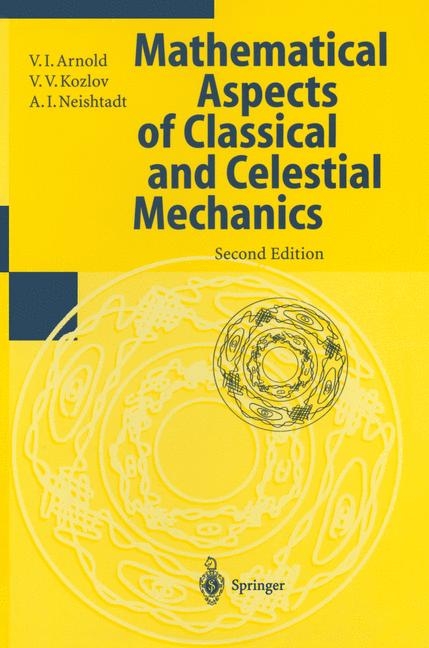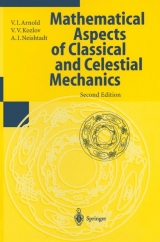Mathematical Aspects of Classical and Celestial Mechanics
Springer Berlin (Verlag)
9783540612247 (ISBN)
- Titel ist leider vergriffen;
keine Neuauflage - Artikel merken
TOC: Contents: V.I. Arnol'd/V.V. Kozlov/A.I. Neishtadt: Mathematical Aspects of Classical and Celestial Mechanics.
1. Basic Principles of Classical Mechanics.- § 1. Newtonian Mechanics.- 1.1. Space, Time, Motion.- 1.2. The Newton-Laplace Principle of Determinacy.- 1.3. The Principle of Relativity.- 1.4. Basic Dynamical Quantities. Conservation Laws.- § 2. Lagrangian Mechanics.- 2.1. Preliminary Remarks.- 2.2. Variations and Extremals.- 2.3. Lagrange’s Equations.- 2.4. Poincare’s Equations.- 2.5. Constrained Motion.- § 3. Hamiltonian Mechanics.- 3.1. Symplectic Structures and Hamilton’s Equations.- 3.2. Generating Functions.- 3.3. Symplectic Structure of the Cotangent Bundle.- 3.4. The Problem of n Point Vortices.- 3.5. The Action Functional in Phase Space.- 3.6. Integral Invariants.- 3.7. Applications to the Dynamics of Ideal Fluids.- 3.8. Principle of Stationary Isoenergetic Action.- § 4. Vakonomic Mechanics.- 4.1. Lagrange’s Problem.- 4.2. Vakonomic Mechanics.- 4.3. The Principle of Determinacy.- 4.4. Hamilton’s Equations in Redundant Coordinates.- § 5. Hamiltonian Formalism with Constraints.- 5.1. Dirac’s Problem.- 5.2. Duality.- § 6. Realization of Constraints.- 6.1. Various Methods of Realizing Constraints.- 6.2. Holonomic Constraints.- 6.3. Anisotropic Friction.- 6.4. Adjoining Masses.- 6.5. Adjoining Masses and Anisotropic Friction.- 6.6. Small Masses.- 2. The ?-Body Problem.- § 1. The Two-Body Problem.- 1.1. Orbits.- 1.2. Anomalies.- 1.3. Collisions and Regularization.- 1.4. Geometry of the Kepler Problem.- § 2. Collisions and Regularization.- 2.1. Necessary Conditions for Stability.- 2.2. Simultaneous Collisions.- 2.3. Binary Collisions.- 2.4. Singularities of Solutions in the ?-Body Problem.- § 3. Particular Solutions.- 3.1. Central Configurations.- 3.2. Homographic Solutions.- 3.3. The Amended Potential and Relative Equilibria.- § 4. Final Motions in the Three-Body Problem.- 4.1. Classification of Final Motions According to Chazy.- 4.2. Symmetry of Past and Future.- § 5. The Restricted Three-Body Problem.- 5.1. Equations of Motion. The Jacobi Integral.- 5.2. Relative Equilibria and the Hill Region.- 5.3. Hill’s Problem.- § 6. Ergodic Theorems in Celestial Mechanics.- 6.1. Stability in the Sense of Poisson.- 6.2. Probability of Capture.- 3. Symmetry Groups and Reduction (Lowering the Order).- § 1. Symmetries and Linear First Integrals.- 1.1. E. Noether’s Theorem.- 1.2. Symmetries in Nonholonomic Mechanics.- 1.3. Symmetries in Vakonomic Mechanics.- 1.4. Symmetries in Hamiltonian Mechanics.- § 2. Reduction of Systems with Symmetry.- 2.1. Lowering the Order (the Lagrangian Aspect).- 2.2. Lowering the Order (the Hamiltonian Aspect).- 2.3. Examples: Free Motion of a Rigid Body and the Three-Body Problem.- § 3. Relative Equilibria and Bifurcations of Invariant Manifolds.- 3.1. Relative Equilibria and the Amended Potential.- 3.2. Invariant Manifolds, Regions of Possible Motions, and Bifurcation Sets.- 3.3. The Bifurcation Set in the Planar Three-Body Problem.- 3.4. Bifurcation Sets and Invariant Manifolds in the Motion of a Heavy Rigid Body with a Fixed Point.- 4. Integrable Systems and Integration Methods.- § 1. Brief Survey of Various Approaches to the Integrability of Hamiltonian Systems.- 1.1. Quadratures.- 1.2. Complete Integrability.- 1.3. Normal Forms.- § 2. Completely Integrable Systems.- 2.1. Action-Angle Variables.- 2.2. Noncommutative Sets of First Integrals.- 2.3. Examples of Completely Integrable Systems.- §3. Some Methods of Integrating Hamiltonian Systems.- 3.1. Method of Separation of Variables.- 3.2. Method of L-A (Lax) Pairs.- §4. Nonholonomic Integrable Systems.- 4.1. Differential Equations with Invariant Measure.- 4.2. Some Solved Problems of Nonholonomic Mechanics.- 5. Perturbation Theory for Integrable Systems.- §1. Averaging of Perturbations.- 1.1. The Averaging Principle.- 1.2. Procedure for Eliminating Fast Variables in the Absence of Resonances.- 1.3. Procedure for Eliminating Fast Variables in the Presence of Resonances.- 1.4. Averaging in Single-Frequency Systems.- 1.5. Averaging in Systems with Constant Frequencies.- 1.6. Averaging in Nonresonant Domains.- 1.7. The Effect of a Single Resonance.- 1.8. Averaging in Two-Frequency Systems.- 1.9. Averaging in Multi-Frequency Systems.- §2. Averaging in Hamiltonian Systems.- 2.1. Application of the Averaging Principle.- 2.2. Procedures for Eliminating Fast Variables.- §3. The KAM Theory.- 3.1. Unperturbed Motion. Nondegeneracy Conditions.- 3.2. Invariant Tori of the Perturbed System.- 3.3. Systems with Two Degrees of Freedom.- 3.4. Diffusion of Slow Variables in Higher-Dimensional Systems, and its Exponential Estimate.- 3.5. Variants of the Theorem on Invariant Tori.- 3.6. A Variational Principle for Invariant Tori. Cantori.- 3.7. Applications of the KAM Theory.- § 4. Adiabatic Invariants.- 4.1. Adiabatic Invariance of the Action Variable in Single-Frequency Systems.- 4.2. Adiabatic Invariants of Multi-Frequency Hamiltonian Systems.- 4.3. Procedure for Eliminating Fast Variables. Conservation Time of Adiabatic Invariants.- 4.4. Accuracy of the Conservation of Adiabatic Invariants.- 4.5. Perpetual Conservation of Adiabatic Invariants.- 6. Nonintegrable Systems.- §1. Near-Integrable Hamiltonian Systems.- 1.1. Poincare’s Methods.- 1.2. Creation of Isolated Periodic Solutions is an Obstruction to Integrability.- 1.3. Applications of Poincare’s Method.- § 2. Splitting of Asymptotic Surfaces.- 2.1. Conditions for Splitting.- 2.2. Splitting of Asymptotic Surfaces is an Obstruction to Integrability.- 2.3. Applications.- § 3. Quasi-Random Oscillations.- 3.1. The Poincare Map.- 3.2. Symbolic Dynamics.- 3.3. Nonexistence of Analytic First Integrals.- § 4. Nonintegrability in the Neighborhood of an Equilibrium Position (Siegel’s Method).- § 5. Branching of Solutions and Nonexistence of Single-Valued First Integrals.- 5.1. Branching of Solutions is an Obstruction to Integrability.- 5.2. Monodromy Groups of Hamiltonian Systems with Single-Valued First Integrals.- § 6. Topological and Geometrical Obstructions to Complete Integrability of Natural Systems with Two Degrees of Freedom.- 6.1. Topology of the Configuration Space of Integrable Systems.- 6.2. Geometrical Obstructions to Integrability.- 7. Theory of Small Oscillations.- §1. Linearization.- § 2. Normal Forms of Linear Oscillations.- 2.1. Normal Form of Linear Natural Lagrangian Systems.- 2.2. The Rayleigh-Fischer-Courant Theorems on the Behavior of Characteristic Frequencies under an Increase in Rigidity and under Imposition of Constraints.- 2.3. Normal Forms of Quadratic Hamiltonians.- § 3. Normal Forms of Hamiltonian Systems Near Equilibria.- 3.1. Reduction to Normal Form.- 3.2. Phase Portraits of Systems with Two Degrees of Freedom in the Neighborhood of an Equilibrium Position under Resonance.- 3.3. Stability of Equilibria in Systems with Two Degrees of Freedom under Resonance.- § 4. Normal Forms of Hamiltonian Systems Near Closed Trajectories.- 4.1. Reduction to the Equilibrium of a System with Periodic Coefficients.- 4.2. Reduction of Systems with Periodic Coefficients to Normal Form.- 4.3. Phase Portraits of Systems with two Degrees of Freedom Near a Closed Trajectory under Resonance.- § 5. Stability of Equilibria in Conservative Fields.- Comments on the Bibliography.- Recommended Reading.
| Erscheint lt. Verlag | 18.12.1996 |
|---|---|
| Reihe/Serie | Dynamical Systems ; 3 | Encyclopaedia of Mathematical Sciences |
| Übersetzer | A. Iacob |
| Zusatzinfo | XIV, 294 p. |
| Verlagsort | Berlin |
| Sprache | englisch |
| Maße | 155 x 235 mm |
| Gewicht | 574 g |
| Themenwelt | Mathematik / Informatik ► Mathematik ► Analysis |
| Naturwissenschaften ► Physik / Astronomie | |
| Schlagworte | Dynamisches System • HC/Mathematik/Analysis • Mechanik • Störung (Math.) • Vielkörperproblem |
| ISBN-13 | 9783540612247 / 9783540612247 |
| Zustand | Neuware |
| Informationen gemäß Produktsicherheitsverordnung (GPSR) | |
| Haben Sie eine Frage zum Produkt? |
aus dem Bereich




